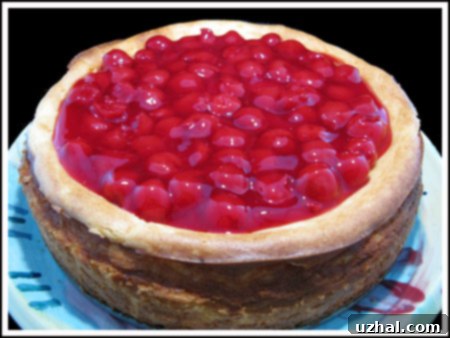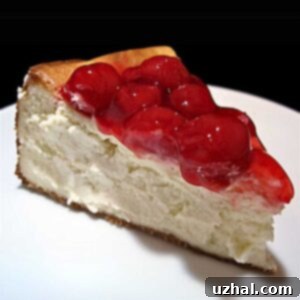Argo Cornstarch Cheesecake: The Vintage Recipe for a Thick, Dense, Restaurant-Style Delight
There’s a reason some recipes stand the test of time, enduring through decades and remaining beloved by generations. The Argo Cornstarch Cheesecake is a shining example, adapted from a vintage recipe originally found on the back of an Argo cornstarch box. While the company may have newer versions on their website today, this classic rendition continues to captivate home bakers, with requests for its specific method frequently surfacing across various online forums and communities. It’s a testament to its timeless appeal, a recipe that has often resided in personal files for years, simply waiting for the perfect occasion to be brought to life. A delightful bonus for many, this particular recipe ingeniously incorporates cottage cheese, contributing to its unique texture and rich flavor profile.

Effortless Preparation: Your Blender or Food Processor is Key
One of the most appealing aspects of this classic Argo Cornstarch Cheesecake recipe is its remarkable ease of preparation. You can begin the process early in the day and watch it come together in mere minutes, all thanks to the efficiency of a trusty blender or food processor. This makes it an ideal choice for busy schedules or when you want to create an impressive dessert without extensive labor. Beyond its speed, another delightful feature of this recipe is its flexibility regarding the crust. While some cheesecake recipes demand intricate crust preparations, this one offers a simpler approach. As someone who appreciates a good graham cracker crust, I initially had reservations about skipping it entirely. However, my worries were quickly dispelled by the sheer grandeur and exquisite texture of the finished product. In this particular adaptation, the inclusion of a loose, thin layer of graham cracker crumbs on the bottom of the pan proved to be more than adequate, providing just the right hint of flavor and texture without overpowering the star of the show – the cheesecake itself. For those who truly prefer a crustless cheesecake, you could even omit the crumbs entirely, allowing the pure, unadulterated flavor of the cheesecake to shine.

The Distinctive Texture of Argo Cornstarch Cheesecake
This isn’t just any cheesecake; it offers a truly unique and satisfying experience. Unlike many traditional cheesecake recipes, this one cleverly eliminates the need for a water bath, simplifying the baking process significantly and removing the worry of water seeping into your delicious dessert. The resulting texture is a hallmark of this recipe: it’s not as overtly creamy or fluffy as some cheesecakes you might encounter. Instead, prepare for a magnificent, dense, silky-smooth, and thick consistency that evokes the kind of luxurious cheesecake you’d typically find at a high-end steakhouse. Each bite is rich and substantial, yet incredibly refined. The flavor profile is equally impressive, often surpassing many other recipes due to its well-rounded complexity. Alongside delicate hints of lemon and vanilla, you’ll discover a delightful tartness from the sour cream and a subtle, comforting butter flavor that perfectly balances and rounds out the overall taste. It’s a symphony of flavors and textures designed to impress.
It’s worth noting that due to its particular structure, this cheesecake may be prone to developing small cracks on its surface during cooling. This is a common occurrence in many dense cheesecakes and in no way affects the flavor or texture. In fact, these minor imperfections create the perfect canvas for a luscious topping. While I had initially planned to prepare Argo’s classic strawberry topping (the recipe is included below), fresh strawberries at my local H.E.B. were disappointingly suboptimal and unusually expensive on that particular day. This highlights the beauty of versatility: you can use any topping you desire, whether it’s a homemade fruit compote, a rich chocolate ganache, or even a simple dollop of whipped cream. Just remember to have a topping plan in mind, as it beautifully complements the cheesecake and adds another layer of enjoyment.
A Nod to Tradition: The Old Argo Pineapple Topping
For those seeking a taste of nostalgia, a big thank you goes to Christine for reminding us of an older version of this beloved recipe that featured a delightful pineapple topping. This particular recipe is believed to be the same or very similar to the original pineapple topping once shared by Argo. It offers a wonderful alternative to the strawberry topping, bringing a tropical zest that beautifully complements the rich cheesecake base.
To create this vibrant topping, combine ½ cup of granulated sugar and 1 tablespoon of cornstarch in a saucepan, whisking them thoroughly to ensure there are no lumps. Next, add a 20 oz can of undrained crushed pineapple, embracing all its juicy goodness, along with 1 tablespoon of fresh lemon juice for a bright, citrusy kick. Place the saucepan over medium heat and stir continuously. The mixture will gradually become glossy and thicken beautifully. Once it reaches your desired consistency, you can serve it warm, allowing its fragrant steam to tantalize your senses, or let it cool completely before spreading it generously over your chilled cheesecake. This pineapple topping adds a fantastic contrast in flavor and texture, making each slice even more irresistible.
The Role of Cornstarch and Cottage Cheese in Cheesecake Perfection
What makes this cheesecake so incredibly special, besides its vintage charm? The answer lies in two key ingredients: cornstarch and cottage cheese. Cornstarch is often seen as a simple pantry staple, but in this recipe, it plays a crucial role in achieving that signature dense, silky texture. Unlike cheesecakes that rely solely on eggs for setting, the cornstarch provides an additional layer of structural integrity. It helps to bind the ingredients, creating a smoother, more stable custard that resists excessive wobbling and contributes to the satisfying “sliceability” of the finished product. This also contributes to minimizing cracking, although as mentioned, some minor surface cracks can still occur. The cornstarch helps ensure a consistent, velvety mouthfeel that is truly exceptional.
Then there’s the cottage cheese – an ingredient that might surprise some in a cheesecake recipe, yet it’s the secret to its distinctive character. The recipe specifically calls for processing the cottage cheese with the eggs until completely smooth. This step is vital, as it eliminates any curds, transforming the cottage cheese into an integral part of the creamy batter. What does it contribute? Cottage cheese adds a subtle tanginess that works beautifully with the sour cream and lemon juice, enhancing the overall brightness of the cheesecake. More importantly, it contributes to the cheesecake’s incredible density without making it heavy or overly rich. It’s a clever way to add body and a unique depth of flavor that sets this Argo Cornstarch Cheesecake apart from purely cream cheese-based versions. For the best results, remember the note: use full-fat cottage cheese, not low-fat, to ensure the optimal richness and texture.
Beyond the Recipe Card: Tips for Your Best Cheesecake
Achieving the perfect cheesecake is an art, but with a few simple tips, you can ensure your Argo Cornstarch Cheesecake turns out flawlessly every time. First and foremost, **room temperature ingredients** are paramount. Softened cream cheese, cottage cheese, sour cream, and eggs blend much more smoothly and evenly, preventing lumps and ensuring a homogenous batter. Cold ingredients will often result in a lumpy texture and may require overmixing, which can incorporate too much air.
When it comes to mixing, **do not overmix**, especially once the cream cheese and other dairy components are incorporated. While you want a smooth batter, overmixing introduces excess air, which can cause the cheesecake to puff up dramatically in the oven and then fall and crack significantly upon cooling. Blend the eggs and cottage cheese until completely smooth, then gently whisk in the remaining ingredients until just combined and smooth. A food processor or blender is excellent for the initial steps, but a whisk can be more controlled for the final additions.
The **cooling process** is just as critical as the baking. After the initial baking time of 1 hour and 15 minutes (or until the edge is firm but the center still has a slight jiggle), resist the urge to immediately remove the cheesecake from the oven. Turning off the oven and allowing the cheesecake to slowly cool inside for exactly one hour helps it set gradually, minimizing temperature shock and reducing the likelihood of major cracks. After this period, remove it from the oven and let it sit at room temperature for a while before transferring it to the refrigerator. This gradual cooling is key to a smooth, uncracked (or minimally cracked) top and a perfectly set interior. Finally, **chill for at least 4 hours**, but if you can, let it chill overnight. Cheesecakes, particularly dense ones like this, truly improve in flavor and texture on day two, making this an excellent make-ahead dessert.
- Cheesecake for Two
- Chocolate Cheesecake Squares
- Cheesecake Bars (Small Batch)
- Out of Flour Cake Mix Cheesecake
- Double Lemon Cheesecake Bars
Recipe

Thick, Dense, Restaurant Style Cheesecake
Anna
Pin Recipe
Ingredients
- ¼ cup graham cracker crumbs
- 4 large eggs
- 1 lb. cottage cheese not low fat, for optimal richness
- 16 oz cream cheese, softened
- 1 ½ cups granulated sugar
- 4 oz salted butter or 4 oz unsalted plus ⅜ teaspoon salt melted and cooled
- ⅓ cup cornstarch
- 2 cups regular sour cream
- 2 tablespoons fresh lemon juice
- 1 teaspoon vanilla extract
Strawberry Topping
- 1 tablespoon cornstarch
- ¼ cup water
- ⅓ cup corn syrup
- ¼ cup crushed strawberries
- 1 teaspoon lemon juice
- 1 ½ cups nice looking whole strawberries
Instructions
-
Preheat your oven to 325 degrees F (160 degrees C). Lightly spray a 9-inch round springform pan with cooking spray. Evenly sprinkle the graham cracker crumbs over the bottom of the pan to form a thin, loose crust.
-
In a blender or food processor, combine the large eggs and cottage cheese. Process until the mixture is completely smooth and no curds remain, scraping down the sides as needed. Gradually add the softened cream cheese to the blender/food processor and continue to blend until thoroughly combined and smooth. Transfer this creamy mixture to a large bowl. Using a whisk, gently incorporate the granulated sugar, melted and cooled butter (salted, or unsalted plus ⅜ tsp salt), cornstarch, regular sour cream, fresh lemon juice, and vanilla extract until the batter is smooth and well-combined. Be careful not to overmix, as this can incorporate too much air.
-
Carefully pour the cheesecake batter into the prepared springform pan. Bake on the center rack of your preheated oven for 1 hour and 15 minutes, or until the edges are set and firm, but the very center still has a slight, gentle jiggle when the pan is lightly moved. Once baked, turn off the oven but leave the cheesecake inside. Let the cheesecake stand in the warm oven for exactly one hour to cool down slowly. This gradual cooling helps prevent cracking. After one hour, remove the cheesecake from the oven and let it sit at room temperature for another period until it is completely cool to the touch.
-
Once completely cool, transfer the cheesecake (still in its pan) to the refrigerator and chill for at least 4 hours. For the absolute best flavor and texture, cheesecakes are often better on day 2, so consider making this ahead of time. When ready to serve, carefully remove the sides of the springform pan. Top with the strawberry topping recipe provided below, or choose any topping you prefer for a beautiful presentation and added flavor.
-
Strawberry Topping: In a medium saucepan, combine the cornstarch, water, corn syrup, and crushed strawberries. Place over medium heat and bring the mixture to a boil, stirring constantly to prevent sticking and ensure even thickening. Allow it to boil for 1 minute. Remove from heat and, for a smoother glaze, strain the mixture through a fine-mesh sieve into a clean bowl (this step is optional but recommended for a professional finish). Stir in the 1 teaspoon of fresh lemon juice. Arrange your nice looking whole (or sliced, if preferred) fresh strawberries decoratively over the top of the chilled cheesecake. Gently spoon or brush the prepared strawberry glaze over the strawberries, ensuring they are beautifully coated.
- Cornstarch Frosting
- Out of Flour Cake Mix Cheesecake
- Cheesecake for Two
- Cheesecake Bars (Small Batch)
- Chocolate Cheesecake Squares
